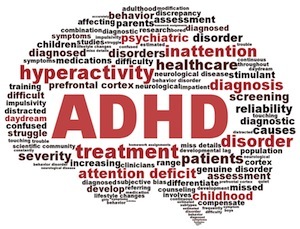Description: Other health impairment - having limited strength, vitality or alertness, including a heightened alertness to environmental stimuli, that results in limited alertness with respect to the educational environment.
** Is due to chronic or acute health problems such as asthma, attention deficit disorder or attention deficit hyperactivity disorder, diabetes, epilepsy, a heart condition, hemophilia, lead poisoning, leukemia, nephritis, rheumatic fever, and sickle cell anemia;
** And adversely affects a child's educational performance.
http://www.scasd.org/cms/lib5/PA01000006/Centricity/Domain/114/13_categories_of_exceptionality_as_defined_by_IDEA.pdf
Indicators:

Inattention
* Has difficulty concentrating
* Has unrelated thoughts
* Has problems focusing and sustaining attention
* Appears to not be listening
* Performance depends on task
* May have better attention to enjoyed activities
* Has difficulty planning, organizing, and completing tasks on time
* Has problems learning new things
* Demonstrates poor self-regulation of behavior, that is, he or she has difficulty monitoring and modifying behavior to fit different situations and settings
Hyperactivity
* Seems unable to sit still (e.g., squirming in his/her seat, roaming around the room, tapping pencil, wiggling feet, and touching everything)
* Appears restless and fidgety
* May bounce from one activity to the next
* Often tries to do more than one thing at once
Impulsivity
* Difficulty thinking before acting (e.g., hitting a classmate when he/she is upset or frustrated)
* Problems waiting his/her turn, such as when playing a game
http://www.ldonline.org/article/Teaching_Children_with_Attention_Deficit_Hyperactivity_Disorder%3A_Instructional_Strategies_and_Practices
Accommodations
Classroom accommodations for students with ADD / ADHD
As a teacher, you can make changes in the classroom to help minimize the distractions and disruptions of ADHD.
Seating
* Seat the student with ADD/ADHD away from windows and away from the door.
* Put the student with ADD/ADHD right in front of your desk unless that would be a distraction for the student.
* Seats in rows, with focus on the teacher, usually work better than having students seated around tables or facing one another in other arrangements.
Information delivery
* Give instructions one at a time and repeat as necessary.
* If possible, work on the most difficult material early in the day.
* Use visuals: charts, pictures, color coding.
* Create outlines for note-taking that organize the information as you deliver it.
Student work
* Create a quiet area free of distractions for test-taking and quiet study.
* Create worksheets and tests with fewer items; give frequent short quizzes rather than long tests.
* Reduce the number of timed tests.
* Test the student with ADD/ADHD in the way he or she does best, such as orally or filling in blanks.
* Show the student how to use a pointer or bookmark to track written words on a page.
* Divide long-term projects into segments and assign a completion goal for each segment.
* Let the student do as much work as possible on computer.
* Accept late work and give partial credit for partial work.
Organization
* Have the student keep a master notebook, a three-ring binder with a separate section for each subject, and make sure everything that goes into the notebook has holes punched and is put on the rings in the correct section.
* Provide a three-pocket notebook insert for homework assignments, completed homework, and “mail” to parents (permission slips, PTA flyers).
* Color-code materials for each subject.
* Allow time for student to organize materials and assignments for home. Post steps for getting ready to go home.
* Make sure the student with ADD/ADHD has a system for writing down assignments and important dates and uses it.
http://www.asha.org/public/speech/disorders/ADHD/
Modifications
Teaching techniques that help students with ADD/ADHD focus and maintain their concentration on your lesson and their work can be beneficial to the entire class.
Starting a lesson
* Signal the start of a lesson with an aural cue, such as an egg timer, a cowbell or a horn. (You can use subsequent cues to show much time remains in a lesson.)
* List the activities of the lesson on the board.
* In opening the lesson, tell students what they’re going to learn and what your expectations are. Tell students exactly what materials they’ll need.
* Establish eye contact with any student who has ADD/ADHD.
Conducting the lesson
* Keep instructions simple and structured.
* Vary the pace and include different kinds of activities. Many students with ADD do well with competitive games or other activities that are rapid and intense.
* Use props, charts, and other visual aids.
* Have an unobtrusive cue set up with the student who has ADD/ADHD, such as a touch on the shoulder or placing a sticky note on the student’s desk, to remind the student to stay on task.
* Allow a student with ADD/ADHD frequent breaks.
* Let the student with ADHD squeeze a rubber ball or tap something that doesn’t make noise as a physical outlet.
* Try not to ask a student with ADD/ADHD perform a task or answer a question publicly that might be too difficult.
Ending the lesson
* Summarize key points.
* If you give an assignment, have three different students repeat it, then have the class say it in unison, and put it on the board.
* Be specific about what to take home
http://www.ldonline.org/article/8797#classroom
